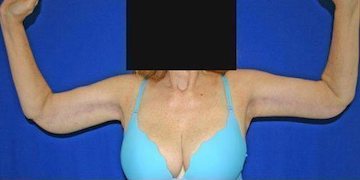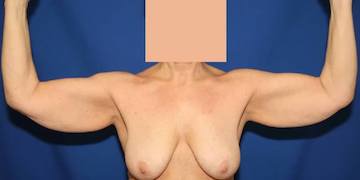Brachioplasty or Arm Lift, Arm Reduction
The arm reduction procedure goes by many names, including the arm lift, armplasty, and brachioplasty. The purpose of an arm reduction is to remove excess skin and or fat of the upper arm. There are different types of arm reductions, including the crescent, modified longitudinal, modified T, and longitudinal brachioplasty. If there is just excess skin and fat in the upper third of the arm, you may do best with a crescent arm lift. During a crescent brachioplasty, an incision is made in the armpit, and a crescent area of excess skin and fat is removed from your upper arm. If you have excess skin and fat that extends partially down the upper arm, you may succeed with the modified longitudinal brachioplasty. This would include an incision from the armpit partway down the upper arm. If you have more excess upper arm skin and fat, you may be a good candidate for a crescent and modified longitudinal. The resulting arm scar is in the shape of the letter “T” and thus, it is called a modified T arm lift. If the excess skin and fat extend to the elbow, you may be a candidate for a longitudinal arm lift where the incision is placed from the armpit to the elbow. Most arm reductions include arm liposuction. Occasionally, arm reductions are covered by your medical insurance. Insurance coverage for a brachioplasty ultimately depends on your anatomic condition, the presence of arm rashes, associated arm skin deformities, and the quality of your health care plan. The arm reduction takes approximately three to four hours to complete. The arm reduction is performed under general anesthesia on an outpatient basis. You will be expected to wear your arm garment for six weeks or more after an arm lift. The recovery is approximately two weeks for an arm lift. Approximately two weeks after an arm reduction, you can return to a sitting job. Around two to three weeks after an arm reduction, you can return to light activity. Heavy gym exercising and lifting weights and deadlifts may require an extended recovery. You should be able to return to a full gym approximately two months after your arm reduction. Most of the arm swelling is gone at approximately eight to ten weeks. Most patients have moderate pain from the arm reduction for approximately three to five days. Drains are usually not involved. Typically, you do not need massages; however, if the arm swelling is significant, you may need several weeks of massage. Once the incisions are healed and there is no drainage, you should apply silicone cream and silicone strips to optimize the resulting arm reduction scar.


Before: Arm Lift Front View After: Arm Lift Front View
(Courtesy of J. Timothy Katzen, MD)


Before: Arm Lift Back View After: Arm Lift Back View
(Courtesy of J. Timothy Katzen, MD)


Before: Arm Lift Front View After: Arm Lift Front View
(Courtesy of J. Timothy Katzen, MD)


Before: Arm Lift Back View After: Arm Lift Back View
(Courtesy of J. Timothy Katzen, MD)


Before: Arm Lift Front View After: Arm Lift Front View
(Courtesy of J. Timothy Katzen, MD)


Before: Arm Lift Back View After: Arm Lift Back View
(Courtesy of J. Timothy Katzen, MD)


Before: Arm Lift Front View After: Arm Lift Front View
(Courtesy of J. Timothy Katzen, MD)


Before: Arm Lift Back View After: Arm Lift Back View
(Courtesy of J. Timothy Katzen, MD)
